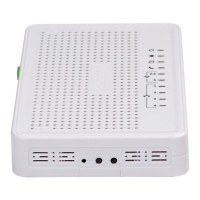____________________________________________________________________________________
____________________________________________________________________________________
46 NTU Optical Network Terminals
– Full—automatic selection mechanism scans and selects a channel from the list of available
channels.
– Legacy—automatic selection mechanism scans and selects a channel from the list of channels
supported by legacy devices (only for 2.4GHz band).
– Custom—automatic selection mechanism scans and selects a channel from the list of channels
defined by the user in Allowed Channel settings.
– 802.11n/EWC—compatibility mode for 802.11n Draft2.0 and EWC (Enhanced Wireless Consortium)
equipment.
– Bandwidth—define the channel width to 20MHzor 40MHz. In 40MHz mode, two adjacent 20MHz bands
are used to increase the channel bandwidth.
– Control Sideband—select the second channel (Lower or Upper) in 40MHz mode.
– 802.11n Rate—define connection rate.
– 802.11n Protection—when enabled, security will be enhanced at the cost of the bandwidth.
– RIFS Advertisement—Reduced Interframe Space, reduces interval between data units (PDUs), increases
Wi-Fi efficiency.
– OBSS Co-Existence—tolerance setting for the chosen mode (20MHz or 40MHz). When set to Enabled, the
optimal device operation mode will be selected with regard to the Bandwidth parameter, otherwise
operation mode will depend only on Bandwidth parameter value.
– RX Chain Power Save Quiet Time—time period during which the traffic must be below the PPS value
before the power saving feature will be activated.
– RX Chain Power Save PPS—the upper limit of PPS (packet per second). If the packets intensity of the
WLAN interface does not exceed this value during the time specified in RX Chain Power Save Quiet Time,
the power saving mode is turned on.
– 54g™ Rate—set the transfer rate in compatibility mode for 54g™ devices.
– Multicast Rate—set the transfer rate for multicast traffic.
– Basic Rate—basic transfer rate.
– Fragmentation Threshold—set the fragmentation threshold in bytes. If the packet size exceeds the
specified value, the packet will be fragmented into parts of a suitable size.
– RTS Threshold—if the packet size is smaller than RTS threshold value, RTS/CTS mechanism (with request
to send/clear to send packets) won't be used.
– DTIM Interval—time period, upon the expiration of which, broadcast and multicast packets placed in the
buffer will be delivered to wireless clients.
– Beacon Interval—time period used for transmission of informational packets, that indicate the activity of
the access point, to the wireless network.
– Max Clients—the maximum number of wireless clients.
– XPress™ Technology—enables bandwidth boost up to 27% in 802.11g networks. In mixed 802.11g and
802.11b networks, XPress™ Technology can boost the bandwidth up to 75%.
– Transmitter Power—define the access point signal power.
– WMM (Wi-Fi Multimedia)—set Wi-Fi Multimedia (WMM) mode. This mode enables fast and high quality
transmission of audio and video content simultaneously with data transmission.
– WMM No Acknowledgement—when this mode is used, the receiving side won't acknowledge received
packets. In a low interference environment, it allows to increase the efficiency of transmission; in a high
interference environment, efficiency of transmission will decrease.
– WMM APSD—enables automatic switching to the power saving mode.
– Beamforming Transmission (BFR)—beamforming feature allows to mitigate the wireless signal
interference and enhance the quality of Wi-Fi connection.
– Beamforming Reception (BFE)—beamforming feature that allows to enhance the quality of Wi-Fi
connection.
Click the Apply/Save button to accept and save the changes.

